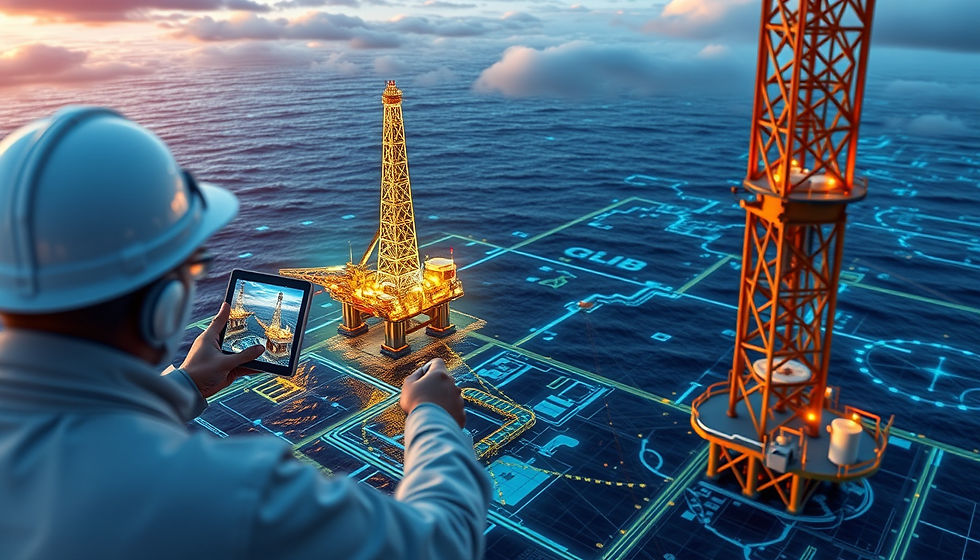Augmented Reality in Energy - AR For Oil and Gas
- Shadnam Khan

- Jul 23
- 4 min read
Updated: Jul 24
Augmented Reality (AR) is redefining how industries operate, and the oil and gas sector is no exception. With the complexities involved in exploration, drilling, and maintenance, oil and gas companies are leveraging AR technologies to enhance efficiency, reduce costs, and improve safety. From training to real-time data overlay during operations, the integration of AR is increasingly becoming a game-changer for the industry.
AR for Oil and Gas: Enhancing Training and Safety
Training is a critical aspect of the oil and gas industry, where safety is of the utmost importance. Traditional training methods can be cost-prohibitive and time-consuming. AR simplifies the training process by providing immersive and interactive experiences.
For example, a trainee can wear AR glasses that overlay digital information onto the real world. They can see how to operate machinery or respond to emergencies in a safe, controlled environment. In this way, AR not only accelerates the learning process but also prepares workers for real-world scenarios without the risks associated with live training.

Furthermore, these AR training programs can be updated in real time, incorporating new safety protocols or technologies without the need for additional resources. According to a study, companies that implement AR in training report a 70% reduction in training time. This efficiency translates into substantial cost savings and increased productivity.
Real-Time Data Visualization in the Field
One of the most practical applications of AR in the oil and gas sector is real-time data visualization. Workers in the field often face challenges in interpreting complex data while performing critical tasks. AR allows fieldworkers to access vital information without the need to consult printed manuals or screens.
Imagine a maintenance technician working on an offshore rig. By utilizing AR glasses, they can overlay schematics and real-time data onto their view of the equipment. This allows them to identify issues, track performance metrics, and plan maintenance actions without having to leap between multiple devices.

According to a report, AR can improve operational efficiency by 30% in the field, significantly reducing downtime and enabling faster decision-making. The ability to access immediate data reduces the risk of errors and enhances communication among teams, which is crucial in an industry where delays can lead to substantial financial losses.
Streamlining Maintenance Operations
Maintenance is a significant cost driver in the oil and gas industry. Traditional methods often involve taking equipment offline for inspections and repairs, which means lost production time and increased costs. AR applications can dramatically change how maintenance is handled.
By leveraging AR technology, engineers can visually inspect equipment using augmented overlays. For instance, AR can guide an engineer to specific components needing attention by highlighting areas on machines in real time. This not only speeds up the maintenance process but also minimizes downtime.
This technology also allows for remote assistance. An on-site engineer can connect with experts miles away and receive guidance through AR overlays. The external expert can see the same view as the engineer and provide instructions or diagnostics seamlessly.

The potential savings from improved maintenance efficiency are substantial. Companies using AR for maintenance report up to a 25% reduction in maintenance costs. This is a major advantage in an industry where margins can be thin.
Improving Exploration and Drilling Accuracy
Exploration and drilling are critical phases in oil and gas operations, heavily reliant on precision and accuracy. Advanced AR technologies are poised to enhance these processes by overlaying geological data and environmental conditions onto the drilling sites directly.
Using AR, geologists and drill operators can visualize subsurface geological formations and potential hazards in real time. This dynamic interaction allows for better decision-making regarding drilling angles and depths, significantly reducing the risk of non-productive time in drilling operations.
In real-world applications, AR has helped companies increase drilling efficiency up to 50%. This not only saves resources but also contributes to more environmentally friendly operations by optimizing drill sites and reducing unnecessary drilling efforts.
Future Outlook: The Role of AR in Oil and Gas
As the oil and gas industry continues to evolve, the role of AR will likely expand. The push towards optimizing operations with technology is more urgent than ever, driven by the need for sustainability and cost-effectiveness.
Statistical analyses suggest that the global AR market will reach $198 billion by 2025, with significant contributions from sectors like oil and gas. Innovations such as better AR devices, integration with AI and IoT, and enhanced data analytics will continue to fuel these advancements.
Augmented reality oil and gas solutions are becoming indispensable as they integrate with existing technologies and provide actionable insights. The companies that adapt to these changes are likely to see significant competitive advantages.
Embracing the Change: Implementing AR Technologies
For companies looking to implement AR in their operations, there are several action steps to consider:
Assess the Current Technology Infrastructure: Evaluate existing systems and identify how AR can integrate seamlessly within them.
Pilot Programs: Start small with pilot programs to test the technology's impact on specific operations before a broader rollout.
Invest in Training: Ensure that employees are well-trained to use AR technologies effectively. This goes beyond traditional training models to immersive experiences that build confidence.
Collaborate with AR Providers: Work with specialized AR technology providers to customize solutions tailored to your company's unique needs.
Focus on Data Management: Implement robust data management practices to ensure that the information overlaid by AR is accurate and up-to-date.
By embracing AR technologies now, oil and gas companies can position themselves as leaders in innovation, enhance safety, and improve operational efficiencies across the board.
As augmented reality continues to evolve, its applications in oil and gas operations will become even more sophisticated, paving the way for a more efficient, cost-effective, and safe industry. For further insights and developments in augmented reality applications, consider exploring more at augmented reality oil and gas.




Comments